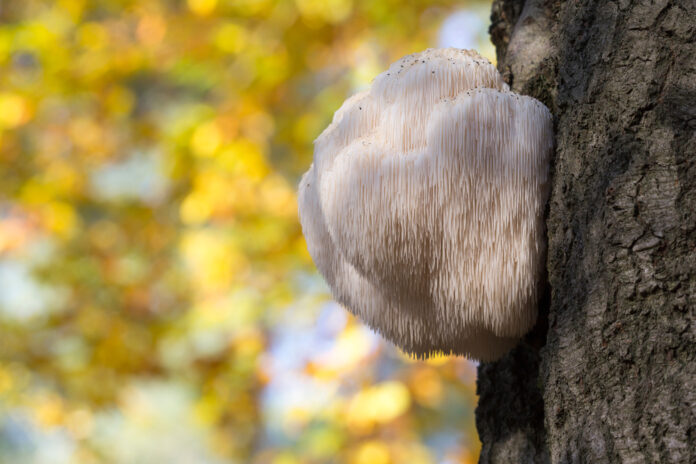Pet food homework: 3 steps to a better bowl
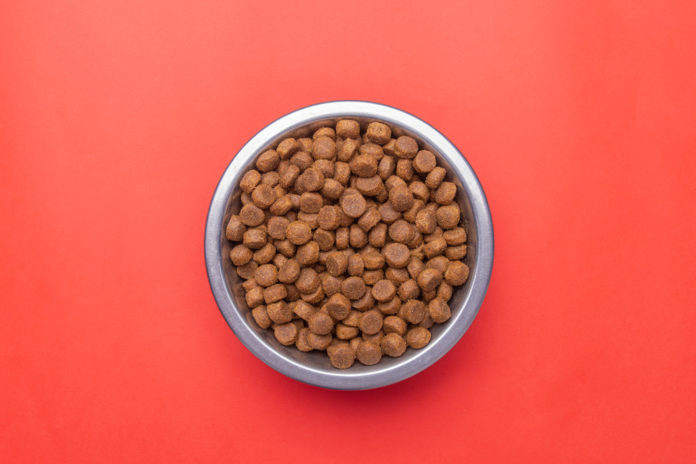
From counting carbs to doing the “adulteration math”, completing your pet food homework helps you select the best food for a “forever dog”.
When Susan completed our Pet Food Homework to learn what she was truly feeding her dog, the results stunned her. Like thousands of others, she had no idea the extent to which her chosen brands delivered biologically inappropriate and overly processed grub that could cut her dog’s life short. It’s important to have complete clarity about your dog’s current food. What follows is a simple method for evaluating his food that yields scores you can use to select the best for a Forever Dog Meal Plan.
Start by asking yourself: “How truly nutritious and health-promoting is my dog’s food? What criteria am I using to come to my conclusion? Is there room for improvement given what I can afford?” The answer to that last question is a resounding yes.
Pet Food Math does a great job revealing areas you may want to address to maximize your dog’s nutrient intake and minimize his consumption of unwanted tagalongs; the goal is to feed the freshest, most nutritionally dense food your budget and lifestyle allow.
/* custom css */
.tdi_15.td-a-rec{
text-align: center;
}.tdi_15 .td-element-style{
z-index: -1;
}.tdi_15.td-a-rec-img{
text-align: left;
}.tdi_15.td-a-rec-img img{
margin: 0 auto 0 0;
}@media (max-width: 767px) {
.tdi_15.td-a-rec-img {
text-align: center;
}
}
Good, better, best
Pet Food Homework allows you to evaluate the food you’re currently feeding, or any new brands of dog food you’re considering. Some ingredients have recurring quality control issues or safety concerns; we call these the Dirty Dozen, and suggest you try to avoid feeding them.
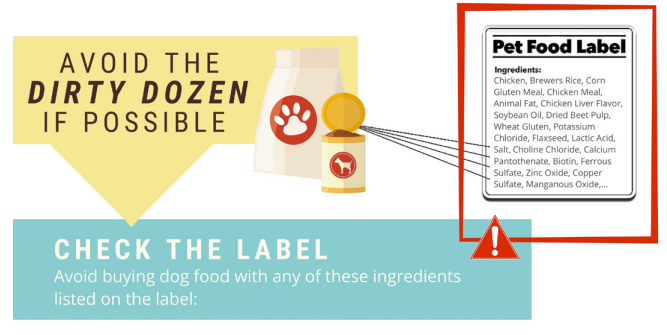
- Any type of meal (i.e. “meat meal”, “poultry meal” or “corn gluten meal”)
- Menadione (synthetic form of vitamin K)
- Peanut hulls (a significant source of mycotoxins)
- Dyes and colors (for example Red #40), including caramel
- Poultry or animal digest
- Animal fat
- Propylene glycol
- Soybean oil, soy flour, ground soybeans, soybean meal, soybean hulls, soybean mill run
- “Oxide” and “sulfate” forms of minerals (for example zinc oxide, titanium dioxide, or copper sulfate)
- Poultry or beef by-products
- BHA, BHT, and ethoxyquin (synthetic preservatives)
- Sodium selenite (synthetic form of selenium)
Step 1: Count your carbs
Calculating the carbohydrate (starch) content in your dog’s food is a powerful way to determine if the diet is biologically appropriate. Dogs evolved eating a high-moisture diet that contained moderate fat and protein and low carbs — the exact opposite of most kibble. The higher the carb content, the less room there is in the diet for lean meats and healthy fats; high carb diets create metabolic stress and inflammation. This calculation will also tell you what you’re paying for: unnecessary starch is cheaper than more expensive meat.
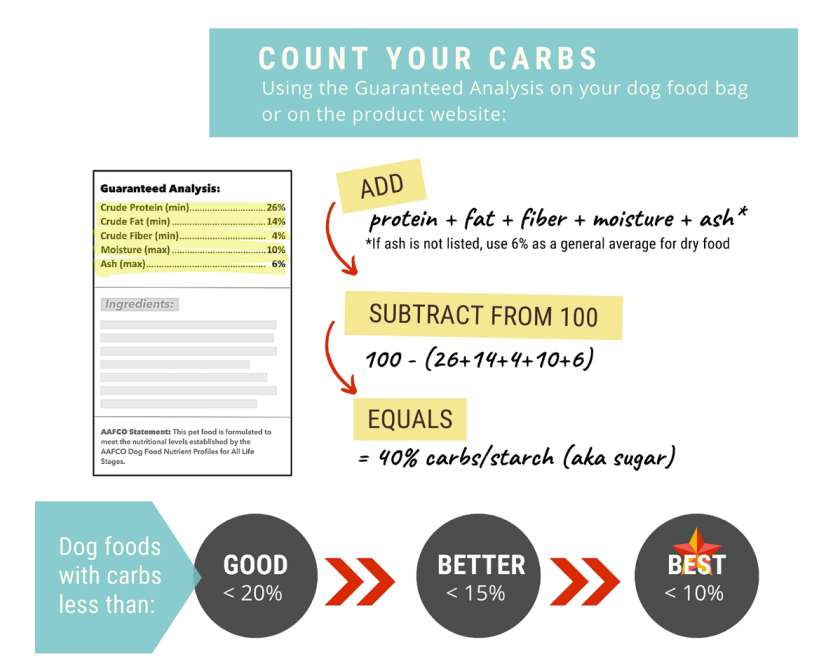
Step 2: Do the adulteration math
Next, determine the level and intensity of food processing. Heating ingredients over and over creates microscopic monsters the pet food industry desperately wants to ignore. The scientific community has known for a long time that heating proteins, fats and carbohydrates to high temperatures creates unwanted chemical reactions in food called Maillard Reaction Products (MRPs).
One of the most common types of MRPs produced in pet food are Advanced Glycation End-products (AGEs), the result of cooking carbohydrates with proteins. We know this reaction occurs in the manufacture of the vast majority of ultra-processed pet foods, and it negatively impacts a dog’s health in about every imaginable way. AGEs have been linked to early organ degeneration, allergic and auto-immune reactions, pancreatitis and GI disorders and a host of other chronic, degenerative disorders, as well as premature aging.
The higher the heat, the longer the food is heated, and the more times it’s heated, the more AGEs are produced. Repeated heating diminishes the nutrient composition and increases the amount of AGEs in the food. You can get some idea of the number of thermal (heat) processes your dog’s food has undergone by looking at how the food was manufactured.
- Unprocessed (raw) or fresh, “flash-processed foods”: Fresh, raw, ingredients that are slightly altered for the purpose of preservation with minimal nutrient loss. Examples include grinding, refrigeration, fermenting, freezing, dehydration, vacuum packaging, and pasteurization. These minimally processed foods have one adulteration.
- Processed foods: The previous category (flash-processed foods) modified again by an additional heat process, so two adulteration processes take place.
- Ultra-processed foods: Industrial creations that contain ingredients not found in home cooking or grocery stores (corn gluten meal, meat meals, high fructose corn syrup, etc.). They require several processing steps using multiple previously-processed ingredients, with additives to enhance taste, texture, color, and flavor, and are produced via baking, smoking, canning or extrusion. Ultra-processed food has multiple heat adulterations. The average bag of extruded food contains ingredients that have undergone high-heat processing an average o four times.
In short, fresh, flash-processed foods have been manipulated (adulterated) fewer times and with no to low heat. Why is this so critically important? The enemies of nutrition are time, heat, and oxygen (which causes oxidation, leading to rancidity). With dog food, heat is the most pervasive offender. Heat negatively impacts the level of nutrients in the food; each time the ingredients are heated, more nutrients are lost.
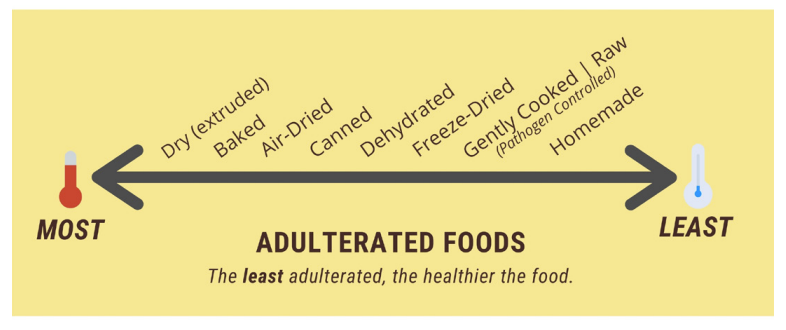 Adulteration math results
Adulteration math results
Good: Previously-processed ingredients blended together, and heat processed once (includes many dehydrated foods).
Better: Raw fresh ingredients blended together and freeze-dried or high-pressure pasteurized (HPP), as well as raw fresh ingredients blended together and processed with no or low heat (includes many raw meat dehydrated and gently cooked foods).
Best: Raw fresh ingredients blended together and served, or frozen (no heat process) to be eaten within three months (includes homemade food, and commercial frozen raw food).
Step 3: Determine synthetic nutrition additions
Finally, determine the source of nutrition in the food. The number of added vitamins and minerals reflects the deficiencies of vitamins and minerals in the raw ingredients and/or the nutrition that was burned off during intense heat processing. For foods labeled nutritionally complete and balanced, required nutrients come from one of two sources: nutrient-dense food ingredients or synthetics (added lab-made vitamins, minerals, amino acids, and fatty acids).
The less nutrient-dense the dog food and/or the more heat used to produce it, the more synthetics must be added. The good/better/best scoring on this assessment is the most subjective of the three steps, depending on your personal food philosophy. In our experience, dog parents tend to feel strongly about this subject, one way or the other. Those who don’t really have an opinion point out that we all eat synthetic vitamins and minerals in many of the fortified foods we consume; others take lots of synthetic vitamins and mineral supplements themselves. For these folks, it’s more acceptable for their dogs to derive the bulk of their micronutrients the same way.
The beauty of Pet Food Math is that you get to decide what’s right for you and your pooch, in light of your personal food philosophy. The math is simply a tool to allow you to make informed decisions about your dog’s diet and health. Adulteration Math is about how many synthetic nutrients must be added back into the product to make it nutritionally adequate. Poorer quality ingredients (usually a food versus feed issue) and fewer nutrient-dense ingredients (always a cost issue) necessarily mean more synthetics.
How to do it
Count the number of synthetic nutrients on the food label. While you’re reading the label or surfing the company’s website, keep your most important food philosophy points in
mind. Added vitamins and minerals can be found on the ingredient panel after the food ingredients. Each nutrient is separated by a comma, so even though you may not be able to pronounce them, you can count how many are included.
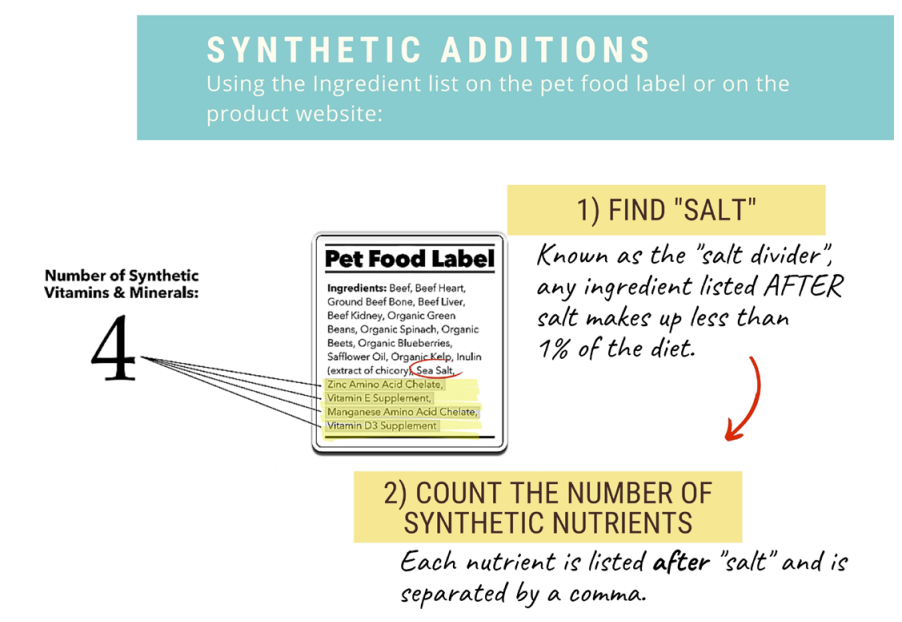
Good: Dog food that contains none of the Dirty Dozen and fewer than 12 synthetic nutrients.
Better: Food that contains none of the Dirty Dozen and fewer than eight synthetic nutrients, with some added health perks: organic ingredients, some GMO-free ingredients, etc.
Best: Food that contains none of the Dirty Dozen, and fewer than four synthetic nutrients, with lots of added health perks: human-grade and organic ingredients, GMO-free, wild-caught/free-range/pastured meats, etc. These are the most expensive products, but also the healthiest.
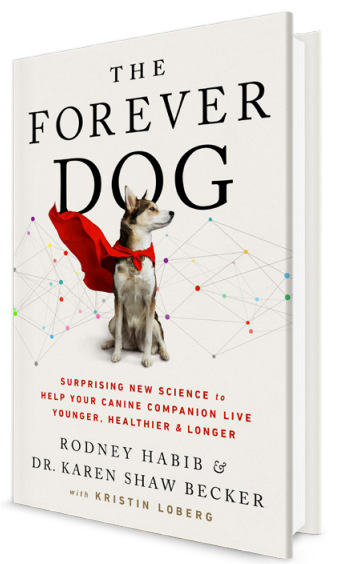 Dog Food Homework provides a frame of reference for you when evaluating brands. These assessment tools help you better understand more about the brands you want to feed (or avoid). They help you make informed, smart decisions for your dog, yourself, your lifestyle and beliefs.
Dog Food Homework provides a frame of reference for you when evaluating brands. These assessment tools help you better understand more about the brands you want to feed (or avoid). They help you make informed, smart decisions for your dog, yourself, your lifestyle and beliefs.
Excerpted from The Forever Dog: Surprising New Science to Help Your Canine Companion Live Younger, Healthier, and Longer by Rodney Habib and Dr. Karen Shaw Becker with Kristin Loberg. This book was written with one goal: to retrain the collective mindset regarding dog health and lifespan. The physical and emotional well-being of our dogs is shaped by the choices we make for them. We all must choose wisely to raise a Forever Dog. This pathbreaking book provides a blueprint, the “how-to’s,” backed by research presented by scientists, and clues from interviewing owners of the oldest dogs in the world. Available worldwide mid-October 2021.
/* custom css */
.tdi_16.td-a-rec{
text-align: center;
}.tdi_16 .td-element-style{
z-index: -1;
}.tdi_16.td-a-rec-img{
text-align: left;
}.tdi_16.td-a-rec-img img{
margin: 0 auto 0 0;
}@media (max-width: 767px) {
.tdi_16.td-a-rec-img {
text-align: center;
}
}



